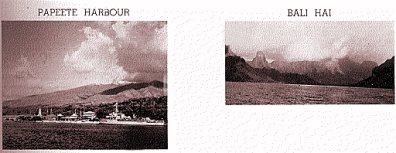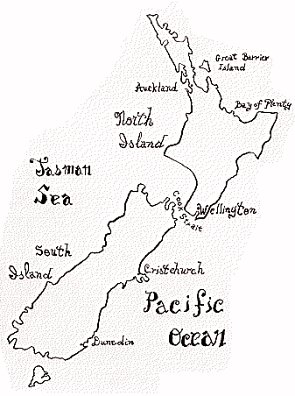


|
|
Picture df46 Tahitian Beauty Tahitian Beauty Bridge top Bridge top
 Picture df47  Papeete Harbour and Bali Hai Papeete Harbour and Bali Hai Bridge top Bridge top
 Picture df48  Welcome and Vance as a Curiosity Welcome and Vance as a Curiosity Bridge top Bridge top
 Picture df49  Map of New Zealand Map of New Zealand Bridge top Bridge top
 Picture df50  New Zealand, one of the Dominions of the British Commonwealth, lies almost exactly on the opposite side of the earth from Great Britain, and about 1,200 miles south-east of Australia. It has a total territiory of 103,410 square miles (almost twice the area of Illinois) and extends 1,000 miles from north to south. New Zealand, one of the Dominions of the British Commonwealth, lies almost exactly on the opposite side of the earth from Great Britain, and about 1,200 miles south-east of Australia. It has a total territiory of 103,410 square miles (almost twice the area of Illinois) and extends 1,000 miles from north to south. The two great islands of New Zealand are mountainous. The highest mountains on North Island are volcanoes at at some distance from the main mountain range. The loftiest volcanoes rise more than 9,000 feet above the sea. Near the volcanoes are hot springs, geysers and mud volcanoes, like those of Yellowstone Park. But New Zeland goes Yellowstone one better by featuring an occasional violent earthquake. New Zealand also boast Sutherland Waterfalls., where the waterdrops 19,00 feet -- nearly the world's record. The two great islands of New Zealand are mountainous. The highest mountains on North Island are volcanoes at at some distance from the main mountain range. The loftiest volcanoes rise more than 9,000 feet above the sea. Near the volcanoes are hot springs, geysers and mud volcanoes, like those of Yellowstone Park. But New Zeland goes Yellowstone one better by featuring an occasional violent earthquake. New Zealand also boast Sutherland Waterfalls., where the waterdrops 19,00 feet -- nearly the world's record. Only the extreme northern tip of the long peninsula of North Island reaches the sup-tropics. Here mangroves grow along the coast. The rest of New Zealand has a temperate climate, somewhat cooler than might be expected in its belt of latitude. The rainfall is moderate except on parts of South Island where the prevailing sea winds from the west and the high mountains together produce heavy rains and snows. Only the extreme northern tip of the long peninsula of North Island reaches the sup-tropics. Here mangroves grow along the coast. The rest of New Zealand has a temperate climate, somewhat cooler than might be expected in its belt of latitude. The rainfall is moderate except on parts of South Island where the prevailing sea winds from the west and the high mountains together produce heavy rains and snows. More than 150 icches of rain a year falls in this south-west corner, and from 50 to 150 inches on all the western slopes of South Island. The eastern half of South Island is much drier, but it still averages twenty-five inches of rain annually. On the whole the climate is healthful and stimulating. More than 150 icches of rain a year falls in this south-west corner, and from 50 to 150 inches on all the western slopes of South Island. The eastern half of South Island is much drier, but it still averages twenty-five inches of rain annually. On the whole the climate is healthful and stimulating. The seasons are simila to those in our temperate zone, but are reversed because New Zealand is in the Southern Hemisphere. The vegetation includes more than 1,000 kinds of plants, most of which are found nowhere else in the world. The seasons are simila to those in our temperate zone, but are reversed because New Zealand is in the Southern Hemisphere. The vegetation includes more than 1,000 kinds of plants, most of which are found nowhere else in the world. There are great forests of hardwoods, green throughout the year. In the rich undergrowth ferns, including tree ferns, grow in great variety. In spite of the fact that there are no native land mamals whatever except bats, the animal life is more peculiar than the vegetation. There are great forests of hardwoods, green throughout the year. In the rich undergrowth ferns, including tree ferns, grow in great variety. In spite of the fact that there are no native land mamals whatever except bats, the animal life is more peculiar than the vegetation. Snakes are absent and the two species of frogs belong to the most primitive group of frogs alive today. The kiwi, a remarkable flighless bird, is occasionally found. Besides its useless wings it has fluffy, hairlike feathers and a long curved bill with nostrils just behind the time. Other bird life includes parrots, amont them the large kea, which sometimes attacks sheep with its sharp beak. There is a good variety of native songbirds. Many foreign animals, fish and birds have been brought to New Zealand. Snakes are absent and the two species of frogs belong to the most primitive group of frogs alive today. The kiwi, a remarkable flighless bird, is occasionally found. Besides its useless wings it has fluffy, hairlike feathers and a long curved bill with nostrils just behind the time. Other bird life includes parrots, amont them the large kea, which sometimes attacks sheep with its sharp beak. There is a good variety of native songbirds. Many foreign animals, fish and birds have been brought to New Zealand.  New Zealand's main industry is sheep raising. Pastures have been greatly improved by the introduction of European grasses. Wool was formerly the primary export, but this now tends to be displaced in importance by frozen meats (both lamb and beef), butter and cheese. The larger cities are Auckland and Wellington on north Island, Christchurch and Dunedin on South Island. New Zealand's main industry is sheep raising. Pastures have been greatly improved by the introduction of European grasses. Wool was formerly the primary export, but this now tends to be displaced in importance by frozen meats (both lamb and beef), butter and cheese. The larger cities are Auckland and Wellington on north Island, Christchurch and Dunedin on South Island. Bridge top Bridge top
|
|
|
You don't have to be a former crew member to sign
Bridge ~ Top of Page ~ Photos ~ Stories ~ Facts